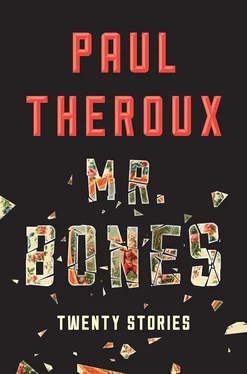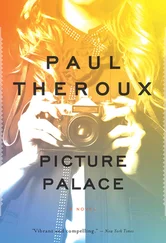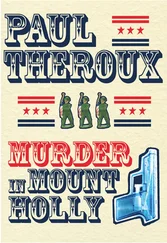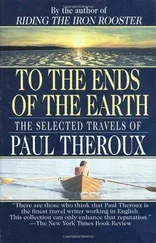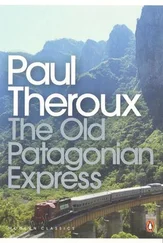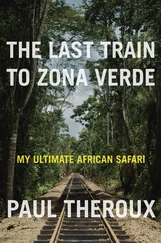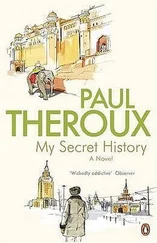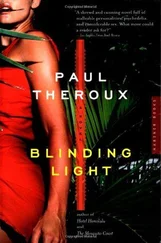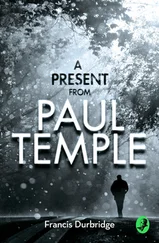No one had said how tiny she was, and misshapen, slightly bent over, almost hunchbacked — probably her age, some sort of fused vertebrae or twisted spine. She was ugly in a startling way, an ugliness that gave her authority, the ruined face, the staring, wide-open blue eyes, the elderly fingers, the walnut-sized rings, putty-like makeup and heavy jewelry, ropes of beads, dangly earrings. She looked like a crone from a folktale — untidy, her hair tousled, her battered suede jacket a poor fit, and she limped a little. No one had mentioned that she was doddery and uncertain, pawing the air as she shuffled along, or that she tried to make this oddness into a kind of majesty.
I felt a bit sorry for her. She knew she wasn’t beautiful, was no longer young, was noticeably frail.
The first thing anyone said about her was the predictable reference to her mountainous name. “One of her husbands” was the explanation — at least four of them, all of them out of the picture. You didn’t think of Mrs. Everest with a man. Her best friends called her “Dickie,” though no one asked how she got that name.
By way of greeting, in that first meeting at the Callanders’, she snatched up a platter and said, “Walter Rainbird! Have some cheese!”
This disarmed me and made me laugh.
“You’re so much bigger than I expected. I wish I could have you in my gallery.”
Some people are blunt because they’re shy. Shyness can even turn them into shouters, if sufficiently riled. Then I thought about her forthright remark, and it became ambiguous: Did she mean that she wanted me, or that she couldn’t possibly exhibit my work? Perhaps she was not so blunt after all.
No one could tell me where Mrs. Everest came from, or her true age, or what her real name was, or how she’d spent her first thirty or so years. She must have been attractive long ago, and being small, still had the pursed lips of a flirt. In the beginning, I asked about her — just wondering aloud. No one would say more than “I really don’t know.”
I was struck by her defiant opinions. Her confidence extended to her business activities: her gallery with its looks-like-art was a success, and was a vortex for the best parties. She knew her own mind, so I thought, and never hesitated to damn something. “I hate it,” she would often say of anything she regarded as conventional. I guessed that she hated my work. Yet I represented money to her, and though she had perhaps a smaller net worth than her clients, she had the big investor’s sense of insecurity, the wealthy person’s fear that without warning she might lose it all.
She respected my financial success more than (if I may say so) my artistic achievement. This was the point: I seldom had shows because my pieces were spoken for in advance, not commissioned but sought-after. Always on the lookout for buyers, she habitually cultivated the rich. She tolerated my wife, Isabel; she never mentioned my work. This was a common occurrence in my life: the way my fame made me a magnet for philistines. People wanted to know me for my success rather than my paintings, because I was good at something and made money off it. As time passed I knew fewer and fewer people who were passionate about art, and more and more socialites, many of them Izzy’s friends, as I smiled in the role of a preoccupied spouse, not a painter at all but rather like someone with a secret vice or a private income.
Though we had no friends on the island, I knew a handful of artists. I made the mistake of introducing Mrs. Everest to two of them. Morrie, who was a sculptor, showed her his studio and then said, “I’ve got some more pieces out back.” She said, “I’ve seen enough.” She was offhand with Marsha, an etcher. I asked her what she thought of Marsha’s work. She said, “Lipstick lesbian.” After this, Morrie and Marsha were cooler toward me. I didn’t blame them.
When she went about wooing me, I was struck with self-conscious fascination, realizing that this little woman, being obvious — but offering attention, grand meals, glittering occasions — was actually succeeding. I saw myself succumbing and wanting more — and getting it; and then I was in her orbit. In ignoring my work, she seemed to imply that she was making an exception in liking me, and that I should be grateful for that. Meals were central to our relationship, food was important, cheese was a theme.
“What they do, no one has ever done before,” Mrs. Everest said of a husband and wife whose photographs she exhibited. Each was a transvestite. They photographed themselves in costume. “That is the proof they are artists.”
At this early stage of my knowing Mrs. Everest, I did not examine this remark. It seemed debatable. My paintings had never been done before. Yet I decided that I liked her conviction. I wanted her to say things like this about me. She didn’t, yet my credentials — the ones that mattered to Mrs. Everest — were soon established.
It happened this way. One weekend in our second year on the island, my wife and I were visited by Andy Wyeth, with Helga Testorf in tow, stopping off on their annual early-summer migration from Pennsylvania to Maine. He flew into our small airport in a private plane. This quickly became news on the island. Where was he staying? What was he doing? Whom was he with? Mrs. Everest had the news early, but it was not until Andy left — he hated socializing — that I revealed to her that he had stayed with us, that I was putting the finishing touches to a portrait of him that I had begun the year before in Port Clyde, Maine. Mrs. Everest only wanted to know about the Helga detail. She said she hated Christina’s World.
“What about Betsy, his wife?” Mrs. Everest asked.
“There’s Betsy’s world and Helga’s world, and Andy proceeds from one to the other,” I said. “Think of it as a kind of informal polygamy.”
This complex shuttling romance bewitched Mrs. Everest, who had the old coquette’s weakness for steamy gossip.
She wanted to see my painting of him, his lined, deeply tanned face like a landscape, his kindly smile, his luminous eyes. In the foreground, one of his hands was lifted, his delicate fingers crooked in the manner of a painter gripping a brush. He had the leathery look of a sportsman, and although he was in his eighties at the time, he seemed much younger — his smile gave him everything, youth and intelligence and confidence. I posed him standing at a window, his sloping meadow and the harbor just visible beyond.
“Why didn’t you give a party for him?”
“He doesn’t go to parties,” I said.
“Helga was so beautiful in those pictures,” Mrs. Everest said. “She must be really old now. Is she fat?”
When I said that Helga was lovely Mrs. Everest took it as a rebuke. I mentioned that Andy had a painting with him, of a cataract on a woodland stream, he called The Carry. He had showed it to me, saying, “I fell in,” and he pointed to the place where, as he had stood painting, he’d stumbled into the water. The picture was real to him, the experience a vivid piece of his history; but he had made it, not installed it.
She wasn’t interested in that, and she frowned at my portrait of Andy, as though concealing her reaction, like a wine snob swilling a sip. They were not the sort of pictures that she would ever exhibit. Yet I had been given face, in the Chinese manner, by this visit by the master of my school of painting. I tried to explain to Mrs. Everest that to me much of Wyeth’s work, especially the later landscapes and coastal scenes, verged on abstract expressionism, or were studies in color. But she wasn’t listening. She cocked her head at my portrait and looked closely, asked more questions about Helga and the Wyeth marriage, and seemed annoyed by my upbeat replies. But this was a turning point for me, my validation, the Wyeth visit.
Читать дальше
